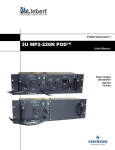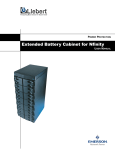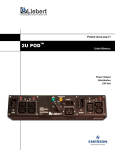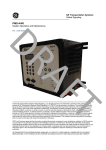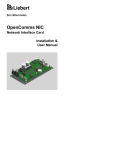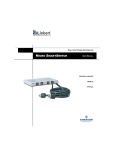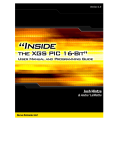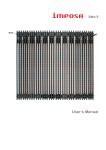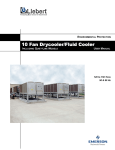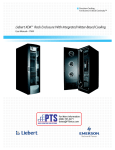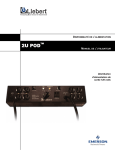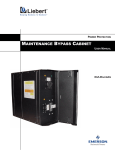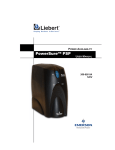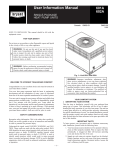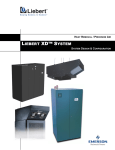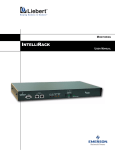Download Liebert Load Bus Synchronization
Transcript
POWER PROTECTION SERIES 610 LOAD BUS SYNC™ USER MANUAL LOAD BUS SYNCHRONIZATION (LBS) MODE SELECT OFF AUTO MASTER SELECT LOAD 1 LOAD 2 LBS ENABLED SYSTEM NON-SYNC LBS ACTIVE LOAD 1 SYNC TO LOAD 2 LOAD 2 SYNC TO LOAD 1 LAMP TEST EXTENDED LOAD BUS SYNCHRONIZATION (ELBS) MODE SELECT OFF AUTO LBS ENABLED SYSTEM NON-SYNC LBS ACTIVE LOAD 1 SYNC TO DMS LAMP TEST TABLE OF CONTENTS 1.0 INTRODUCTION . . . . . . . . . . . . . . . . . . . . . . . . . . . . . . . . . . . . . . . . . . . . . . . . . . . . . . . . . .1 1.1 System Description. . . . . . . . . . . . . . . . . . . . . . . . . . . . . . . . . . . . . . . . . . . . . . . . . . . . . . . . . . . 1 1.1.1 Passive or Active Synchronization. . . . . . . . . . . . . . . . . . . . . . . . . . . . . . . . . . . . . . . . . . . . . . . . 1 2.0 PASSIVE LOAD BUS SYNCHRONIZATION . . . . . . . . . . . . . . . . . . . . . . . . . . . . . . . . . . . . . . .2 2.1 General Description . . . . . . . . . . . . . . . . . . . . . . . . . . . . . . . . . . . . . . . . . . . . . . . . . . . . . . . . . . 2 2.2 Load Bus Synchronization Circuit . . . . . . . . . . . . . . . . . . . . . . . . . . . . . . . . . . . . . . . . . . . . . . 2 2.3 System Operation . . . . . . . . . . . . . . . . . . . . . . . . . . . . . . . . . . . . . . . . . . . . . . . . . . . . . . . . . . . . 2 2.4 System Interlocks . . . . . . . . . . . . . . . . . . . . . . . . . . . . . . . . . . . . . . . . . . . . . . . . . . . . . . . . . . . . 3 2.5 Operation—Passive Load Bus Synchronization . . . . . . . . . . . . . . . . . . . . . . . . . . . . . . . . . . . . 4 2.5.1 2.5.2 Operator Controls . . . . . . . . . . . . . . . . . . . . . . . . . . . . . . . . . . . . . . . . . . . . . . . . . . . . . . . . . . . . . 4 Operator Procedures. . . . . . . . . . . . . . . . . . . . . . . . . . . . . . . . . . . . . . . . . . . . . . . . . . . . . . . . . . . 4 3.0 PASSIVE EXTENDED LOAD BUS SYNCHRONIZATION WITH LIEBERT UPS SYSTEMS . . . . . . . .5 3.1 System Description. . . . . . . . . . . . . . . . . . . . . . . . . . . . . . . . . . . . . . . . . . . . . . . . . . . . . . . . . . . 5 3.2 Extended Load Bus Synchronization & MSDA Controllers. . . . . . . . . . . . . . . . . . . . . . . . . . . 6 3.3 System Operation . . . . . . . . . . . . . . . . . . . . . . . . . . . . . . . . . . . . . . . . . . . . . . . . . . . . . . . . . . . . 7 3.4 System Interlocks . . . . . . . . . . . . . . . . . . . . . . . . . . . . . . . . . . . . . . . . . . . . . . . . . . . . . . . . . . . . 7 3.5 Operation—Passive Extended Load Bus Synchronization With Liebert UPS Systems . . . . 7 3.5.1 3.5.2 Operator Controls . . . . . . . . . . . . . . . . . . . . . . . . . . . . . . . . . . . . . . . . . . . . . . . . . . . . . . . . . . . . . 7 Operator Procedures. . . . . . . . . . . . . . . . . . . . . . . . . . . . . . . . . . . . . . . . . . . . . . . . . . . . . . . . . . . 8 4.0 PASSIVE EXTENDED LOAD BUS SYNCHRONIZATION WITH MIXED UPS SYSTEMS . . . . . . . . .9 4.1 System Description. . . . . . . . . . . . . . . . . . . . . . . . . . . . . . . . . . . . . . . . . . . . . . . . . . . . . . . . . . . 9 4.2 Extended Load Bus Synchronization Controllers. . . . . . . . . . . . . . . . . . . . . . . . . . . . . . . . . . 10 4.3 System Operation . . . . . . . . . . . . . . . . . . . . . . . . . . . . . . . . . . . . . . . . . . . . . . . . . . . . . . . . . . . 10 4.4 System Interlocks . . . . . . . . . . . . . . . . . . . . . . . . . . . . . . . . . . . . . . . . . . . . . . . . . . . . . . . . . . . 10 4.5 Operation—Passive Extended Load Bus Synchronization With Mixed UPS Systems . . . . 10 4.5.1 4.5.2 Operator Controls . . . . . . . . . . . . . . . . . . . . . . . . . . . . . . . . . . . . . . . . . . . . . . . . . . . . . . . . . . . . 10 Operator Procedures. . . . . . . . . . . . . . . . . . . . . . . . . . . . . . . . . . . . . . . . . . . . . . . . . . . . . . . . . . 11 5.0 ACTIVE LOAD BUS SYNC™—AVAILABLE ONLY FOR TWO UPS SYSTEMS . . . . . . . . . . . . . 12 5.1 General Description . . . . . . . . . . . . . . . . . . . . . . . . . . . . . . . . . . . . . . . . . . . . . . . . . . . . . . . . . 12 5.2 Load Bus Synchronization Circuit . . . . . . . . . . . . . . . . . . . . . . . . . . . . . . . . . . . . . . . . . . . . . 12 5.3 System Operation . . . . . . . . . . . . . . . . . . . . . . . . . . . . . . . . . . . . . . . . . . . . . . . . . . . . . . . . . . . 12 5.4 System Interlocks . . . . . . . . . . . . . . . . . . . . . . . . . . . . . . . . . . . . . . . . . . . . . . . . . . . . . . . . . . . 13 5.5 Operation—Active Load Bus Synchronization . . . . . . . . . . . . . . . . . . . . . . . . . . . . . . . . . . . . 13 5.5.1 5.6 Operator Controls . . . . . . . . . . . . . . . . . . . . . . . . . . . . . . . . . . . . . . . . . . . . . . . . . . . . . . . . . . . . 13 Operator Procedures . . . . . . . . . . . . . . . . . . . . . . . . . . . . . . . . . . . . . . . . . . . . . . . . . . . . . . . . 14 i FIGURES Figure 1 Figure 2 Figure 3 Figure 4 Figure 5 Figure 6 Figure 7 Figure 8 Figure 9 Load bus synchronization components . . . . . . . . . . . . . . . . . . . . . . . . . . . . . . . . . . . . . . . . . . . . . . . 2 LBS control panel . . . . . . . . . . . . . . . . . . . . . . . . . . . . . . . . . . . . . . . . . . . . . . . . . . . . . . . . . . . . . . . . 3 Extended load bus synchronization—all Liebert UPS . . . . . . . . . . . . . . . . . . . . . . . . . . . . . . . . . . . 5 ELBS control panel . . . . . . . . . . . . . . . . . . . . . . . . . . . . . . . . . . . . . . . . . . . . . . . . . . . . . . . . . . . . . . . 6 Master select and distribution assembly (MSDA). . . . . . . . . . . . . . . . . . . . . . . . . . . . . . . . . . . . . . . 6 Extended load bus synchronization—mixed UPS systems. . . . . . . . . . . . . . . . . . . . . . . . . . . . . . . . 9 ELBS control panel . . . . . . . . . . . . . . . . . . . . . . . . . . . . . . . . . . . . . . . . . . . . . . . . . . . . . . . . . . . . . . . 9 Load bus synchronization components . . . . . . . . . . . . . . . . . . . . . . . . . . . . . . . . . . . . . . . . . . . . . . 12 ALBS control panel . . . . . . . . . . . . . . . . . . . . . . . . . . . . . . . . . . . . . . . . . . . . . . . . . . . . . . . . . . . . . . 13 ii Introduction 1.0 INTRODUCTION 1.1 System Description Liebert’s Load Bus Sync™ (LBS) option keeps the output of two or more independent Uninterruptible Power Supply systems in synchronization, even when the systems are operating from different power sources. Any UPS will typically synchronize to its bypass source. As long as the UPS systems are tied to the same input and bypass sources, they will automatically stay in synchronization. However, if the UPS systems are operating on batteries, on different backup generators or asynchronous bypass sources, their outputs will tend to drift out of synchronization. Maintaining synchronization is critically important for installations with dual power distribution systems. These sites typically feature Liebert Precision Power Centers (PPC) with Liebert Static Bus Transfer Switches (STSs). Each STS has dual inputs: it can receive power from any connected UPS, and switch seamlessly among the UPS systems as long as the UPS outputs are held in close synchronization. This provides redundancy down to the PPC level. It also permits one half of the distribution system (upstream of the STS) to be taken offline for maintenance or repairs. NOTE In this manual reference to a UPS system may mean either a single-module UPS or a System Control Cabinet (SCC) of a multi-module system. 1.1.1 Passive or Active Synchronization Two forms of LBS are available, Passive and Active. The form required for your system depends on the number of UPS systems, whether the Liebert UPS systems are the same model and whether the Liebert UPS systems are paired with another manufacturer’s UPS. Passive LBS - One UPS system is selected as Master, the others become Slaves. During normal operation all systems will function independently of each other. Should the UPS systems lose synchronization with each other for more than a pre-determined period of time, the slave UPSs will synchronize with the master UPS. Active LBS - In an Active LBS system, the Slave UPS system is constantly tracking the Master UPS system. Depending on the number of UPSs in the LBS system and whether they are all of Liebert manufacture will dictate the configuration required. There are three possible configurations: • Load Bus Synchronization—Two Liebert UPS systems • Extended Load Bus Synchronization (ELBS) with Liebert UPS systems—Three or more Liebert UPS systems • Extended Load Bus Synchronization (ELBS) with mixed UPS systems—Two UPS systems of different Liebert models or one Liebert UPS and one non-Liebert UPS 1 Passive Load Bus Synchronization 2.0 PASSIVE LOAD BUS SYNCHRONIZATION The Load Bus Sync™ (LBS) option consists of an interface board in each UPS plus one LBS control panel installed between the UPSs. Figure 1 Load bus synchronization components LBS Interface Board LBS Control Panel UPS System #1 2.1 LBS Interface Board UPS System #2 General Description The Liebert Load Bus Sync option works by synchronizing the slave UPS (DSS) to the output of the master UPS (DMS). Furthermore, the LBS is dormant until the two UPSs drift more than a predetermined amount out of synchronization. There are no other connections between the logic or controls of either UPS. This ensures maximum system independence and reliability. 2.2 Load Bus Synchronization Circuit The LBS is a controller that fits into a compact 20 x 24 inch (508 x 610mm) enclosure (see Figure 2). Front panel controls are simple and fault tolerant. They enable the operator to select: 1. Whether the circuit will function automatically or be “Off,” and 2. Whether UPS #1 or UPS #2 will be the Designated Master System (DMS). The other UPS system then becomes the Designated Slave System (DSS). 2.3 System Operation The LBS option performs the following functions: 1. Continuously senses the phase relationship between the outputs of the two UPSs that make up the system. 2. If the two systems lose synchronization with each other for more than a predetermined period of time (adjustable from 2 to 5 seconds), the LBS will synchronize the Designated Slave System (DSS) to the Designated Master System (DMS) if the Auto/Off switch is in the Auto position. DSS and DMS are selected manually via the master system select switch. If the DSS is on bypass and unable to synchronize to the DMS, the DMS will then synchronize to the output bus of the DSS. This re-selection of master will be accomplished automatically. 3. Continuously monitors the quality and synchronization of the bypass input voltage to both systems. Once quality and synchronization between the two have been re-established for five seconds, the LBS will revert to separate synchronization for both systems, each synchronized to its own bypass. 4. Failure of any part of the LBS controls will not cause system failure. The worst case effect of a failure in the LBS will be a failure of the two systems to synchronize with each other during times when both systems are not synchronized to utility power. 2 Passive Load Bus Synchronization 2.4 System Interlocks System interlocks are used on the LBS: • The designated slave system has a manual transfer prohibit. • The static switch inhibit will be governed by the comparison of bypass and critical bus phase of the slave system and the LBS control panel. • To start a slave system, the LBS must be turned off to transfer the inverter on-line. • Shutting down a slave system requires turning the LBS to Off to transfer the UPS to bypass manually. Figure 2 LBS control panel LOAD BUS SYNCHRONIZATION (LBS) MODE SELECT OFF AUTO MASTER SELECT LOAD 1 LOAD 2 LBS ENABLED SYSTEM NON-SYNC LBS ACTIVE LOAD 1 SYNC TO LOAD 2 LOAD 2 SYNC TO LOAD 1 LAMP TEST 20" 508mm) 3 24" 610mm) Passive Load Bus Synchronization 2.5 Operation—Passive Load Bus Synchronization 2.5.1 Operator Controls Operation of the LBS has been kept as simple as possible. There are only three controls and five indicator lights on the LBS control panel. Refer to Figure 2. The indicators are: • LBS Enabled. Indicates that the load bus synchronization circuitry is in the Automatic mode. • System Non-Synchronization. Indicates that the DSS is no longer in synchronization with the DMS. This alarm will indicate during the transition from internal bypass synchronization to DMS synchronization. • LBS Active. Indicates that the LBS circuitry has taken over the synchronization of the UPS. If the System Non-Synchronization indicator is also on, it means that synchronization is in process. • Load 1 Synchronization to Load 2. Indicates that the UPS critical bus is synchronized to the output of the DMS, in this case UPS #2. This indicator will turn on when the synchronization process is complete. • Load 2 Synchronization to Load 1. Indicates that the UPS critical bus is synchronized to the output of the DMS, in this case UPS #1. This indicator will turn on when the synchronization process is complete. NOTE All indicators mentioned above are available via Form C dry contacts for remote monitoring. LBS controls are: • Mode Select Switch. Provides manual selection of automatic operation or “Off” modes. In the Automatic mode, the LBS will be enabled. In the Off mode, both UPSs will synchronize independently. • Master Select Switch. Provides manual selection of the DMS source. The LBS circuitry will automatically switch DMS sources should the initially selected DSS transfer to bypass. • Lamp Test. Push this button to test indicator lights. 2.5.2 Operator Procedures The only two operator controls are the Mode Select Switch and the Master Select Switch. The Mode Select Switch can be left in the Automatic position all the time. The Off position can be selected at times when it is desired to let the UPSs synchronize independently. The Master Select Switch allows the operator to choose which UPS will provide the reference synchronization signal. In normal operation, both UPS systems will be functioning and the LBS Mode Select Switch will be in the Automatic position. The LBS Enable indicator will be lit, as will one of the indicators for Load X synchronization to Load Y. If the two UPS drift out of synchronization (while on generator or battery, for example), the LBS Active and System Non-Sync indicators will be lighted. The Load X Synchronization to Load Y indicator will be off during the synchronization process and turn back on when the process is complete. 4 Passive Extended Load Bus Synchronization with Liebert UPS Systems 3.0 PASSIVE EXTENDED LOAD BUS SYNCHRONIZATION WITH LIEBERT UPS SYSTEMS 3.1 System Description The Extended Load Bus Sync™ option consists of an interface board and an ELBS panel for each UPS, plus one Master Select and Distribution Assembly (MSDA) for the complete system. For multimodule systems, the interface board will be in each System Control Cabinet (SCC). The ELBS assemblies are packaged in wall-mount enclosures, with each mounted as close as possible to the UPS being controlled. The MSDA is also packaged in a wall-mount enclosure and installed near the UPS chosen as the Designated Master System (DMS). The other UPS systems will be considered Designated Slave Systems (DSS). Figure 3 Extended load bus synchronization—all Liebert UPS LBS Interface Board ELBS Control Panel Master Select & Distribution Assembly (MSDA) UPS System #1 ELBS Control Panel LBS Interface Board UPS System #2 ELBS Control Panel ELBS Control Panel LBS Interface Board LBS Interface Board UPS System #4 UPS System #3 The Liebert ELBS option works by synchronizing the various slave UPSs (DSS) to the output of the DMS. The ELBS is dormant until the UPS systems drift out of synchronism by more than a predetermined amount. There are no other connections between the logic or controls of the UPS systems. This ensures maximum system independence and reliability. 5 Passive Extended Load Bus Synchronization with Liebert UPS Systems Figure 4 ELBS control panel EXTENDED LOAD BUS SYNCHRONIZATION (ELBS) LBS ENABLED MODE SELECT OFF SYSTEM NON-SYNC AUTO LBS ACTIVE LOAD 1 SYNC TO DMS LAMP TEST 3.2 Extended Load Bus Synchronization & MSDA Controllers The ELBS controller fits into a compact 20x24 inch (508 x 610mm) enclosure. There are two controls on the front panel: • Mode Select Switch—Provides manual selection of whether the circuit will function automatically or be “Off,” and • Lamp Test—Push to test indicator lights The MSDA Controller has one control: • Master Select Switch: Provides manual selection of DMS Source. Two or more UPSs feed the MSDA, so the selection of the DMS would either be Source 1 or Source 2, with Source 1 being the first choice and Source 2 being the contingency source. Figure 5 Master select and distribution assembly (MSDA) MASTER SELECT AND DISTRIBUTION ASSEMBLY (MDSA) MASTER SELECT Source 2 UPS 1 Source 3 UPS 2 Source 1 Source 4 UPS 3 UPS 4 NOTE A four-UPS System unit is shown. MSDA units are available for three, four, five and six UPS systems. 6 Passive Extended Load Bus Synchronization with Liebert UPS Systems 3.3 System Operation The ELBS option performs the following functions: • Continuously senses the phase relationship between the outputs of the slave UPSs (DSS) and the DMS. • If the systems lose synchronization with each other for more than a predetermined period of time (adjustable from 2 to 5 seconds), the ELBS will synchronize the Designated Slave Systems (DSS) to the Designated Master System (DMS) if the mode switch is in the Auto position. DSS and DMS are selected manually via the master system select switch on the MSDA. • Continuously monitors the quality and synchronization of the bypass input voltage to all systems. Once quality and synchronization have been re-established for five seconds, the ELBS will revert to separate synchronization for all systems, each synchronized to its own bypass. • Failure of any part of the ELBS controls will not cause system failure. The worst case effect of a failure in the ELBS will be a failure of the systems to synchronize with each other during times when the systems are not synchronized to utility power. 3.4 System Interlocks System interlocks are used on the ELBS: • The designated slave system has a manual transfer prohibit. • The static switch inhibit will be governed by the comparison of bypass and critical bus phase of the slave system and the ELBS control panel. • To start a slave system, the ELBS must be turned off to transfer the inverter on-line. • Shutting down a slave system requires turning the ELBS to Off to transfer the UPS to bypass manually. 3.5 Operation—Passive Extended Load Bus Synchronization With Liebert UPS Systems 3.5.1 Operator Controls Operation of the ELBS has been kept as simple as possible. The system indicator lights are: • ELBS Enabled (on ELBS control panel)—Indicates that the load bus synchronization circuitry is in the Automatic mode. • System Non-Sync (on ELBS control panel)—Indicates that the DSS is no longer in synchronization with the DMS. This alarm will indicate during the transition from internal bypass synchronization to DMS synchronization. • ELBS Active (on ELBS control panel)—Indicates that the LBS circuitry has taken over the synchronization of the UPS. If the System Non-Sync indicator is also on, it means that synchronization is in process. • Load Sync to DMS (on ELBS control panel)—Indicates that the critical load bus is synchronized to the output of the DMS. This indicator will turn on when the synchronization process is complete. • UPS 1 (on MSDA)—Indicates that UPS 1 is the DMS. • UPS (2-X) (on MSDA)—Indicates that UPS 2 (or 3 or 4) is the DMS. NOTE: All indicators above are available via Form C dry contacts for remote monitoring. ELBS controls are: • Mode Select—Provides manual selection of automatic operation or “Off” modes. In the Automatic mode, the ELBS will be enabled. In the Off mode, slave UPSs will synchronize independently (see Figure 4). • Lamp Test—Press this button to test indicator lights (see Figure 4). MSDA control is: • Master Select. Provides manual selection of the DMS source. The ELBS circuitry will automatically switch DMS sources should the initially selected DMS lose its bypass input (see Figure 5). 7 Passive Extended Load Bus Synchronization with Liebert UPS Systems 3.5.2 Operator Procedures The only two operator controls are the Mode Select Switch and the Master Select Switch. The Mode Select Switch can be left in the Automatic position all the time. The Off position can be selected for maintenance or other times when it is desired to let the UPSs synchronize independently. The Master Select Switch allows the operator to choose which UPS will provide the reference synchronization signal. In normal operation, all UPS systems will be functioning and the ELBS Mode Select switch will be in the Automatic position. The LBS Enable indicator will be lit, as will the indicator for Load Sync to DMS. If one of the UPSs drifts out of synchronization (while on generator or battery, for example), the LBS Active and System Non-Sync indicators will be lit. The Load Sync to DMS indicator will be off during the synchronization process and turn back on when the process is complete. 8 Passive Extended Load Bus Synchronization With Mixed UPS Systems 4.0 PASSIVE EXTENDED LOAD BUS SYNCHRONIZATION WITH MIXED UPS SYSTEMS 4.1 System Description The Extended Load Bus Sync™ (ELBS) option for mixed UPS systems permits synchronizing the outputs of a combination of either: • different models of Liebert UPS systems OR • a Liebert UPS and a non-Liebert UPS. The option consists of an interface board and an ELBS assembly for the Liebert UPS designated as the slave system (DSS), plus one fuse kit for the Designated Master System (DMS). If a non-Liebert UPS system is used, that UPS will always be designated as the master system. If different Liebert UPS models are connected, one Liebert UPS system will be designated as the master system. For multi-module systems, the interface board will be in the Liebert System Control Cabinet (SCC). The ELBS assembly is packaged in a wall-mount enclosure, mounted as close as possible to the UPS being controlled. Figure 6 Extended load bus synchronization—mixed UPS systems LBS Interface Board ELBS Control Panel Liebert UPS System (always designated slave in this configuration) Fuse Kit Designated Master UPS System The ELBS option works by bringing the DSS into synchronization with the DMS. Furthermore, the ELBS is dormant until the DSS drifts more than a predetermined amount out of synchronization with the DMS. There are no other connections between the logic or controls of the UPSs. This ensures maximum system independence and reliability. Figure 7 ELBS control panel EXTENDED LOAD BUS SYNCHRONIZATION (ELBS) LBS ENABLED MODE SELECT OFF SYSTEM NON-SYNC AUTO LBS ACTIVE LOAD 1 SYNC TO DMS LAMP TEST 9 Passive Extended Load Bus Synchronization With Mixed UPS Systems 4.2 Extended Load Bus Synchronization Controllers The ELBS Controller fits into a compact 20x24 inch enclosure. There are only two front panel controls: • Mode Select Switch: Provides manual selection of whether the circuit will function automatically or be “Off,” and • Lamp Test: Push to test indicator lights. 4.3 System Operation The ELBS option performs the following functions: • Continuously senses the phase relationship between the outputs of the UPSs that make up the system. • If the systems lose synchronization with each other for more than a predetermined period of time (adjustable from 2 to 5 seconds), the ELBS will synchronize the DSS to the DMS • Continuously monitors the quality and synchronization of the output voltage of the DSS. Once quality and synchronization have been re-established for five seconds, the ELBS will revert to separate synchronization for the DSS, each synchronized to its own bypass. • Failure of any part of the ELBS controls will not cause system failure. The worst case effect of a failure in the ELBS will be a failure of the systems to synchronize with each other during times when the systems are not synchronized to utility power. 4.4 System Interlocks System interlocks are used on the ELBS: • The designated slave system has a manual transfer prohibit. • The static switch inhibit will be governed by the comparison of bypass and critical bus phase of the slave system and the ELBS control panel. • To start a slave system, the ELBS must be turned off to transfer the inverter on-line. • Shutting down a slave system requires turning the ELBS to Off to transfer the UPS to bypass manually. 4.5 Operation—Passive Extended Load Bus Synchronization With Mixed UPS Systems 4.5.1 Operator Controls Operation of the ELBS has been kept as simple as possible. The system indicator lights are: • ELBS Enabled—Indicates that the load bus synchronization circuitry is in the Automatic mode. • System Non-Sync—Indicates that the DSS is no longer in synchronization with the DMS. This alarm will indicate during the transition from internal bypass synchronization to DMS synchronization. • ELBS Active—Indicates that the LBS circuitry has taken over the synchronization of the UPS. If the System Non-Synchronization indicator is also on, it means that synchronization is in process. • Load 1 Sync to DMS—Indicates that the critical load bus is synchronized to the output of the DMS. This indicator will turn on when the synchronization process is complete. NOTE: All indicators above are available via Form C dry contacts for remote monitoring. ELBS controls are: • Mode Select—Provides manual selection of automatic operation or “Off” modes. In the Automatic mode, the ELBS will be enabled. In the Off mode, both UPSs will synchronize independently (see Figure 4). • Lamp Test—Press this button to test indicator lights (see Figure 4). 10 Passive Extended Load Bus Synchronization With Mixed UPS Systems 4.5.2 Operator Procedures The only operator control is the Mode Select Switch. The Mode Select Switch can be left in the Automatic position all the time. The Off position can be selected for maintenance or other times when it is desired to let the UPSs synchronize independently. In normal operation, all UPS systems will be functioning and the ELBS Mode Select switch will be in the Automatic position. The ELBS Enable indicator will be lit, as will the indicator for Load Sync to DMS. If one of the UPSs drifts out of synchronization (while on generator or battery, for example), the ELBS Active and System Non-Sync indicators will be lit. The Load Sync to DMS indicator will be off during the synchronization process and turn back on when the process is complete. 11 Active Load Bus Sync™—Available Only for Two UPS Systems 5.0 ACTIVE LOAD BUS SYNC™—AVAILABLE ONLY FOR TWO UPS SYSTEMS The Active Load Bus Sync™ option consists of an interface board in each UPS plus one LBS control panel installed between the UPSs. Figure 8 Load bus synchronization components LBS Interface Board Active LBS Control Panel UPS System #1 5.1 LBS Interface Board UPS System #2 General Description Liebert’s Active Load Bus Synchronization (ALBS) option works by synchronizing the DSS to the output of the DMS. There are no other connections between the logic or controls of either UPS. This ensures maximum system independence and reliability. 5.2 Load Bus Synchronization Circuit The ALBS is a controller that fits into a compact 20x24 inch (508 x 610mm) enclosure (see Figure 9). Front panel controls are simple and fault tolerant. They enable the operator to select: • Whether the circuit will function automatically or be Off and • Whether UPS #1 or UPS #2 will be the Designated Master System (DMS). The other UPS system then becomes the Designated Slave System (DSS). 5.3 System Operation The ALBS option performs the following functions: • Continuously senses the phase relationship between the outputs of the two UPSs that make up the system. • When ALBS is turned to Load 1 or Load 2 (via the front panel switch) it will wait 5 seconds, then synchronize the designated slave system to designated master system. • The slave system will remain synchronized to the master system until the ALBS control panel switch is turned to the OFF position or: • The master system synchronization signal goes away (out of voltage tolerance) in which case the slave system will return to synchronization with its internal bypass. • The slave system goes to bypass, in which case, if critical voltage is available at the slave system, the slave system will become the master system and the other connected system will become the slave system and synchronize to the system in bypass. • If the original slave system comes off bypass and resumes normal operation, the ALBS will return the UPS systems to their original master/slave configuration (the manually selected master system again is designated as master, with a 5 second delay to ensure system stability). Failure of any part of the ALBS controls will not cause system failure. The worst case effect of a failure in the ALBS will be a failure of the two systems to synchronize with each other during times when both systems are not synchronized to utility power. 12 Active Load Bus Sync™—Available Only for Two UPS Systems 5.4 System Interlocks System interlocks are used on the ALBS: • The designated slave system has a manual transfer prohibit. • The static switch inhibit will be governed by the comparison of bypass and critical bus phase of the slave system and the ALBS control panel. • To start a slave system, the ALBS must be turned off to transfer the inverter on-line. • Shutting down a slave system requires turning the ALBS to Off to transfer the UPS to bypass manually. Figure 9 ALBS control panel LOAD BUS SYNCHRONIZATION (LBS) LBS ENABLED MASTER SELECT LOAD 1 OFF SYSTEM NON-SYNC LOAD 2 LBS ACTIVE LOAD 1 SYNC TO LOAD 2 LOAD 2 SYNC TO LOAD 1 LAMP TEST 5.5 Operation—Active Load Bus Synchronization 5.5.1 Operator Controls Operation of the ALBS has deliberately been kept as simple as possible. There are only two controls and five indicator lights on the LBS enclosure. Refer to Figure 2. The indicators are: • LBS Enabled. Indicates that the load bus sync circuitry is in the Automatic mode. • System Non-Sync. Indicates that the DSS is no longer in sync with the DMS. This alarm will indicate during the transition from internal bypass sync to DMS sync. • LBS Active. Indicates that the LBS circuitry has taken over the sync of the UPS. If the System Non-Sync indicator is also on, it means that synchronization is in process. • Load 1 Sync to Load 2. Indicates that the UPS critical bus is synchronized to the output of the DMS, in this case UPS #2. This indicator will turn on when the sync process is complete. • Load 2 Sync to Load 1. Indicates that the UPS critical bus is synchronized to the output of the DMS, in this case UPS #1. This indicator will turn on when the sync process is complete. NOTE All indicators mentioned above are available via Form C dry contacts for remote monitoring. ALBS controls are: • Master Select Switch (three position switch). Provides manual selection of the DMS source. • Lamp Test. Push this button to test indicator lights. 13 Active Load Bus Sync™—Available Only for Two UPS Systems 5.6 Operator Procedures The only operator control is the Master Select Switch. This switch allows the operator to choose which UPS will provide the reference synchronization signal. The Off position can be selected at times when it is desired to let the UPSs synchronize independently. In normal operation, both UPS systems will be functioning and the Master Select Switch will be in the Load 1 or load 2 position. The LBS Enable indicator will be lit, as will one of the indicators for Load X Synchronization to Load Y. 14 POWER PROTECTION SERIES 610 Load Bus Sync™ The Company Behind the Products With over a million installations around the globe, Liebert is the world leader in computer protection systems. Since its founding in 1965, Liebert has developed a complete range of support and protection systems for sensitive electronics: • • • • • Environmental systems—close-control air conditioning from 1 to 60 tons Power conditioning and UPS with power ranges from 300 VA to more than 1000 kVA Integrated systems that provide both environmental and power protection in a single, flexible package Monitoring and control—from systems of any size or location, on-site or remote Service and support through more than 100 service centers around the world and a 24/7 Customer Response Center While every precaution has been taken to ensure the accuracy and completeness of this literature, Liebert Corporation assumes no responsibility and disclaims all liability for damages resulting from use of this information or for any errors or omissions. © 2005 Liebert Corporation All rights reserved throughout the world. Specifications subject to change without notice. ® Liebert and the Liebert logo are registered trademarks of Liebert Corporation. All names referred to are trademarks or registered trademarks of their respective owners. SL-30105 (3/05) Rev. 1 USER MANUAL Technical Support/Service Web Site www.liebert.com Monitoring 800-222-5877 [email protected] Outside the US: 614-841-6755 Single-Phase UPS 800-222-5877 [email protected] Outside the US: 614-841-6755 Three-Phase UPS 800-543-2378 [email protected] Environmental Systems 800-543-2778 Outside the United States 614-888-0246 Locations United States 1050 Dearborn Drive P.O. Box 29186 Columbus, OH 43229 Italy Via Leonardo Da Vinci 8 Zona Industriale Tognana 35028 Piove Di Sacco (PD) +39 049 9719 111 Fax: +39 049 5841 257 Asia 23F, Allied Kajima Bldg. 138 Gloucester Road Wanchai Hong Kong +852 2 572 2201 Fax: +852 2 831 0114




















